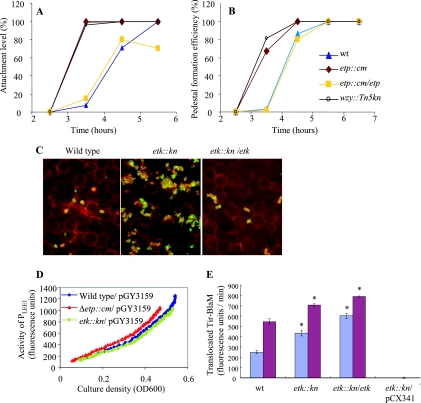FIG. 4.
The G4C interferes with EHEC interaction with host cells at early time points postinfection. (A and B) The efficiency of adherence (A) and of pedestal formation (B) by wild-type (wt) EHEC was compared to that of G4C-deficient etp and wzy mutants. Hep2 cells were infected with overnight cultures (OD, ∼1.0; multiplicity of infection, ∼2) of wild-type EHEC, the wzy::Tn5 and etp::Cm mutants, and the complemented etp::Cm/etp mutant. At different time points postinfection, the cells were fixed and the actin cytoskeleton was stained with rhodamine-phalloidin. The slides were analyzed by microscopy and scored for the percentage of Hep2 cells associated with more than eight attached bacteria (A, percent attachment) and for the percentage of Hep2 cells associated with more than five pedestals (B, percent actin pedestal formation). In all cases, the standard errors obtained in the experiments were below 14% (error bars are not shown to simplify the figure). In panel A, the wzy graph overlaps that of etp::Cm and thus it is hard to see it. (C) Similarly, we also infected monolayers of immobilized RBC, as described in the text, with wild-type EHEC, the etk::kan mutant, and a complemented mutant (etk::kan/etk). At 4 h postinfection, the infected RBC were fixed and stained (bacteria and RBC are in red, and EspA filaments are in green). The images shown were taken from a representative experiment out of two, and in both cases, the attachment of the etk mutant was increased by ∼6-fold in comparison to wild-type EHEC and by ∼14-fold in comparison to the complemented etk mutant (data not shown). (D) Activity of the LEE1 promoter in etp and etk mutants. A plasmid containing a gfp gene transcriptionally fused to the LEE1 regulatory region (pGY3159) was introduced into wild-type EHEC and the etp and etk mutants. Overnight bacterial cultures were diluted 1:50 in CDMEM in 96-well plates, which were immediately placed in a plate reader preset at 37°C. Bacteria were grown within the plate reader under infection conditions without shaking, and growth (OD600) and the activity of the LEE1 promoter (fluorescence levels) were monitored at 120-s intervals. Shown is a representative experiment out of three. (E) Tir translocation by the EHEC etk::kan mutant. EHEC strains containing a plasmid encoding TirEHEC-BlaM (pKB3105) were used to infect HeLa cells. At 3 h (blue columns) or 3:45 h (red columns) postinfection, the cells were loaded with CCF2 and the rate of CCF2 hydrolysis in the cells, reflecting the amount of translocated Tir-BlaM, was determined as described in Materials and Methods. The genotypes of the strains used are indicated below the columns. As a negative control, we used an etk::kan mutant containing a plasmid expressing unfused blaM (pCX341). Each column represents the average translocation by six different colonies, and the bars indicate the standard errors. A representative experiment out of three is shown. Mutants were compared to the wild type by both parametric and nonparametric unpaired tests, and significant differences (P < 0.05) are indicated by asterisks.

